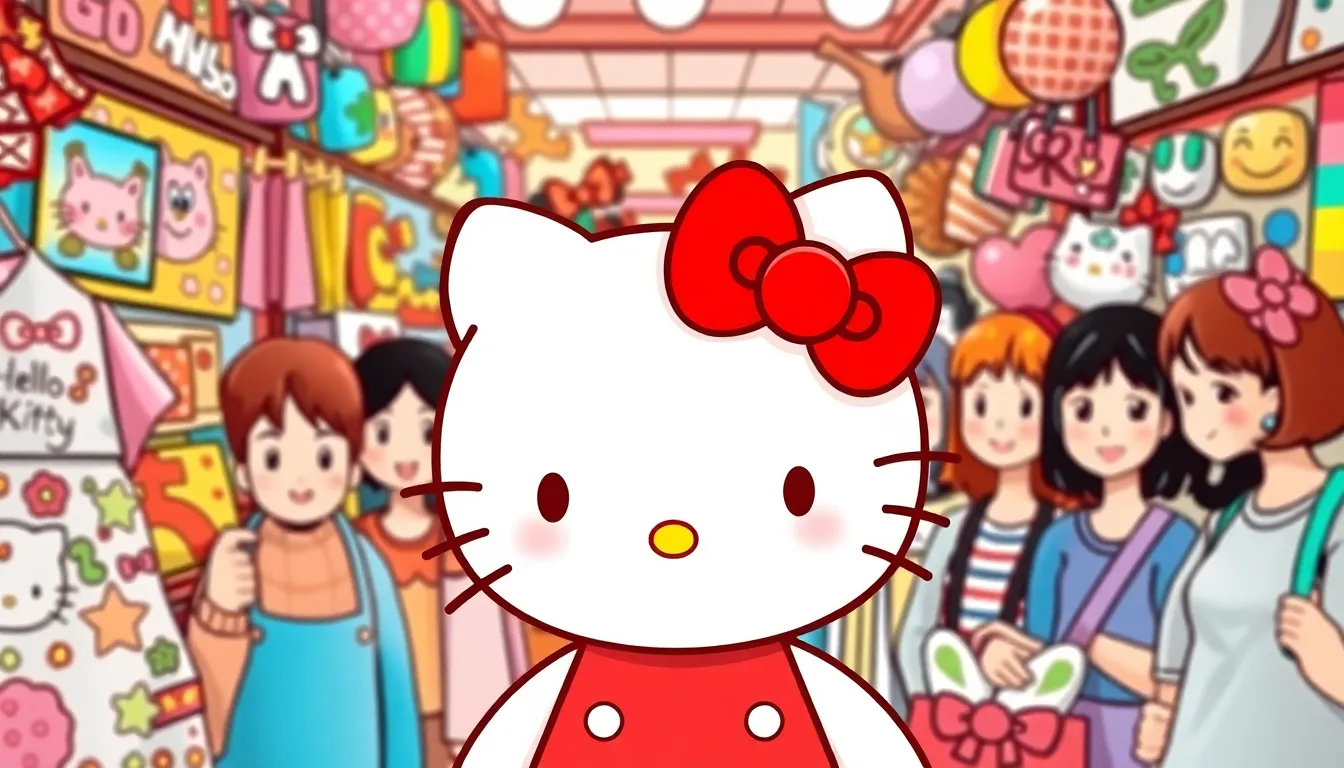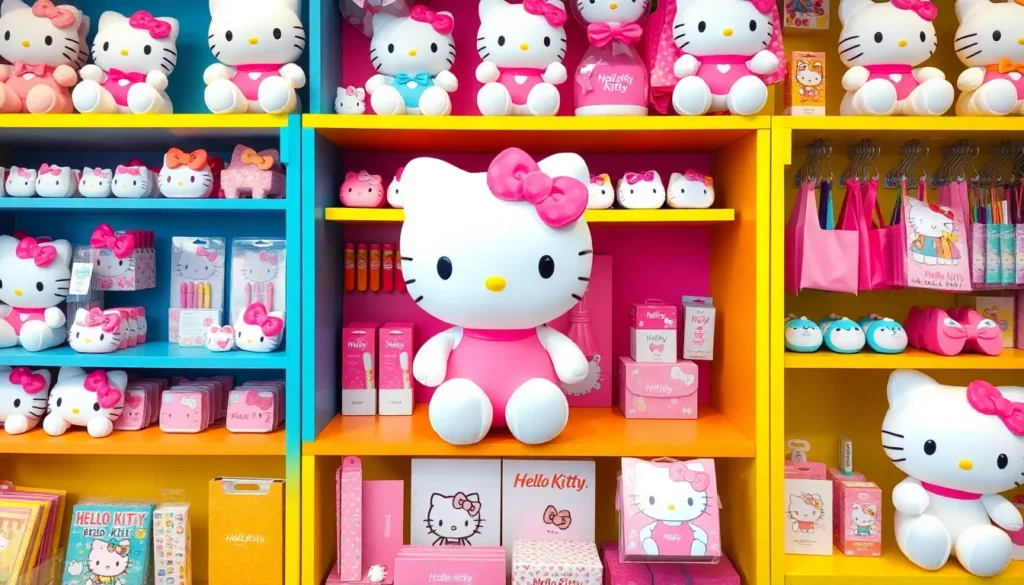Hello Kitty has captured hearts worldwide with her adorable charm and signature bow. However, many fans might be surprised to learn that this beloved character isn’t actually a cat. Created by Sanrio in 1974, Hello Kitty is officially described as a “little girl” who happens to resemble a cat. This distinction has sparked curiosity and debate among fans and pop culture enthusiasts alike.
Exploring the nuances of Hello Kitty’s identity reveals fascinating insights into her design and the marketing genius behind her success. As misconceptions persist, it’s essential to delve deeper into the character’s origins and the messages she embodies. Understanding that Hello Kitty is not a cat opens up a new perspective on her role in popular culture and the impact she’s had on generations.
Table of Contents
ToggleOverview of Sanrio Hello Kitty
Hello Kitty, created by the Japanese company Sanrio in 1974, has transcended the boundaries of traditional characters. Designed by Yuko Shimizu, Hello Kitty is recognized worldwide and has become a cultural icon. No whiskers distinguish her facial features, setting her apart visually from an actual cat.
Character traits highlight her as friendly, caring, and optimistic. A central theme in her branding focuses on friendship and kindness, appealing to a broad audience. Products associated with Hello Kitty include stationary, clothing, accessories, and home goods. This extensive merchandise range reinforces her status as a lifestyle brand.
The character’s global popularity derives from strategic marketing and collaborations. Licensing agreements have allowed Hello Kitty to appear alongside numerous brands, enhancing visibility and desirability. The character’s design incorporates simplicity and cuteness, fostering emotional connections with fans.
Understanding Hello Kitty’s identity as a fictional character, rather than a feline, changes appreciation dynamics among consumers. This distinction emphasizes the character’s role within the larger context of pop culture and the impact she has on various generations.
The Controversy Behind “Not A Cat”

The revelation that Hello Kitty is not a cat incited intrigue and debate among fans and critics alike, challenging long-held perceptions of the character. This discussion encompasses her origins, fan reactions, and the implications for her brand identity.
Understanding Hello Kitty’s Background
Hello Kitty, created by Sanrio in 1974, was designed as a “little girl” named Kitty White. This character design deviates from typical feline features, such as the absence of whiskers. The decision to portray her in this manner reflects a strategic marketing choice aimed at appealing to a diverse audience. Kitty’s childhood persona emphasizes innocence and friendship, which are central themes in her branding. Such a portrayal has allowed her to transcend cultural boundaries, resonating with children and adults around the globe.
Examination of Fan Reactions
Fan reactions to Hello Kitty’s identity range from shock to acceptance. Some fans express disappointment at learning that she is not an actual cat, feeling misled by her cat-like appearance. Conversely, other fans appreciate the complexity behind her character, embracing her as a symbol of positivity. Discussions on social media platforms often highlight this divided sentiment, showcasing various perspectives among Hello Kitty enthusiasts. This debate reflects broader discussions around character identity in pop culture, underscoring her unique position as both a cartoon character and a lifestyle brand.
Cultural Impact of Hello Kitty
Hello Kitty’s presence in popular culture transcends mere character recognition. Her influence extends to fashion, music, and lifestyle, reflecting her status as an emblem of cultural phenomena.
Hello Kitty in Popular Culture
Hello Kitty has appeared in various forms of media, including TV shows, films, and video games. She has made cameos in popular series, such as “The Simpsons” and “Adventure Time,” demonstrating her wide appeal. Collaborative projects with renowned artists and designers have further cemented her role in the arts. Major events like the Sanrio Puroland amusement park attract millions, reinforcing her status as a cultural hub for fans. The character’s representation in art exhibitions, such as the “Hello Kitty: Fashion and Friends” exhibit, showcases her impact on contemporary art discussions.
Merchandise and Branding
Hello Kitty boasts an extensive array of merchandise, from clothing to home décor. In 2021, her product offerings were worth an estimated $1 billion globally. Partnerships with high-profile brands like Sephora, MAC, and Vans expand her reach beyond traditional children’s merchandise. This diversity showcases her versatility and appeal across different demographics. The branding strategy leverages her cute and optimistic image, creating a lifestyle brand that captivates a broad audience. Licensing agreements with manufacturers enhance her visibility, allowing Hello Kitty to remain relevant in an ever-evolving consumer market.
Artistic Representation of Hello Kitty
Hello Kitty’s artistic representation plays a crucial role in her identity and brand appeal. Created by designer Yuko Shimizu, Hello Kitty features a simple, minimalist design that emphasizes her character traits. The absence of whiskers and a mouth contributes to a universal appeal, allowing fans to project their emotions onto her.
Hello Kitty’s aesthetic incorporates vibrant colors and appealing patterns, enhancing her visibility in various forms of media. Designs often include iconic accessories like bows and uniforms, which reinforce her friendly and approachable persona.
The character’s versatility in art is evident through collaborations with various artists and designers. Unique interpretations appear in fashion, art exhibitions, and merchandise, underscoring her influence in contemporary culture. Examples include artist Takashi Murakami’s playful reinterpretations and luxury fashion brands integrating her image into high-end collections.
Merchandising strategies also align closely with her artistic representation. Puzzles, figurines, and clothing items feature Hello Kitty in diverse scenarios, capturing niche markets across demographics. Such wide-ranging products illustrate how her design adapts to contemporary trends while maintaining core characteristics.
Additionally, art events and exhibitions like “Hello Kitty: Fashion and Friends” highlight her significance in the art world. These displays explore her evolution, showcasing how her design resonates across generations. The continued relevancy of Hello Kitty in art and culture emphasizes the character’s enduring charm and adaptability.
Hello Kitty’s identity as a “little girl” rather than a cat reshapes how fans and consumers perceive her. This revelation invites deeper appreciation for her role as a cultural icon and highlights the significance of her design choices. The absence of whiskers and her friendly demeanor reinforce her status as a symbol of positivity and kindness.
As Hello Kitty continues to evolve through collaborations and merchandise, her influence spans various aspects of pop culture. The ongoing conversations surrounding her identity reflect broader themes in character representation and consumer engagement. Embracing her true nature allows fans to connect with her on a more meaningful level, ensuring her relevance for generations to come.



